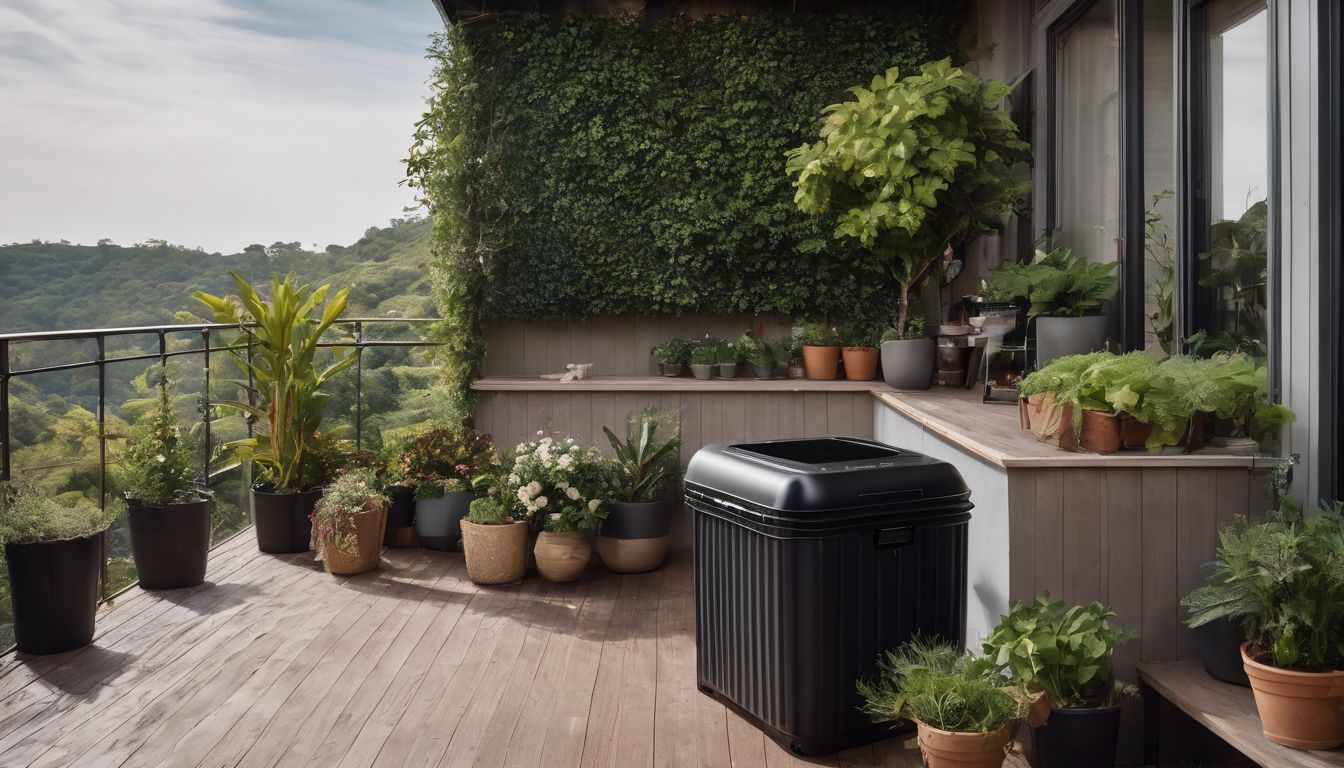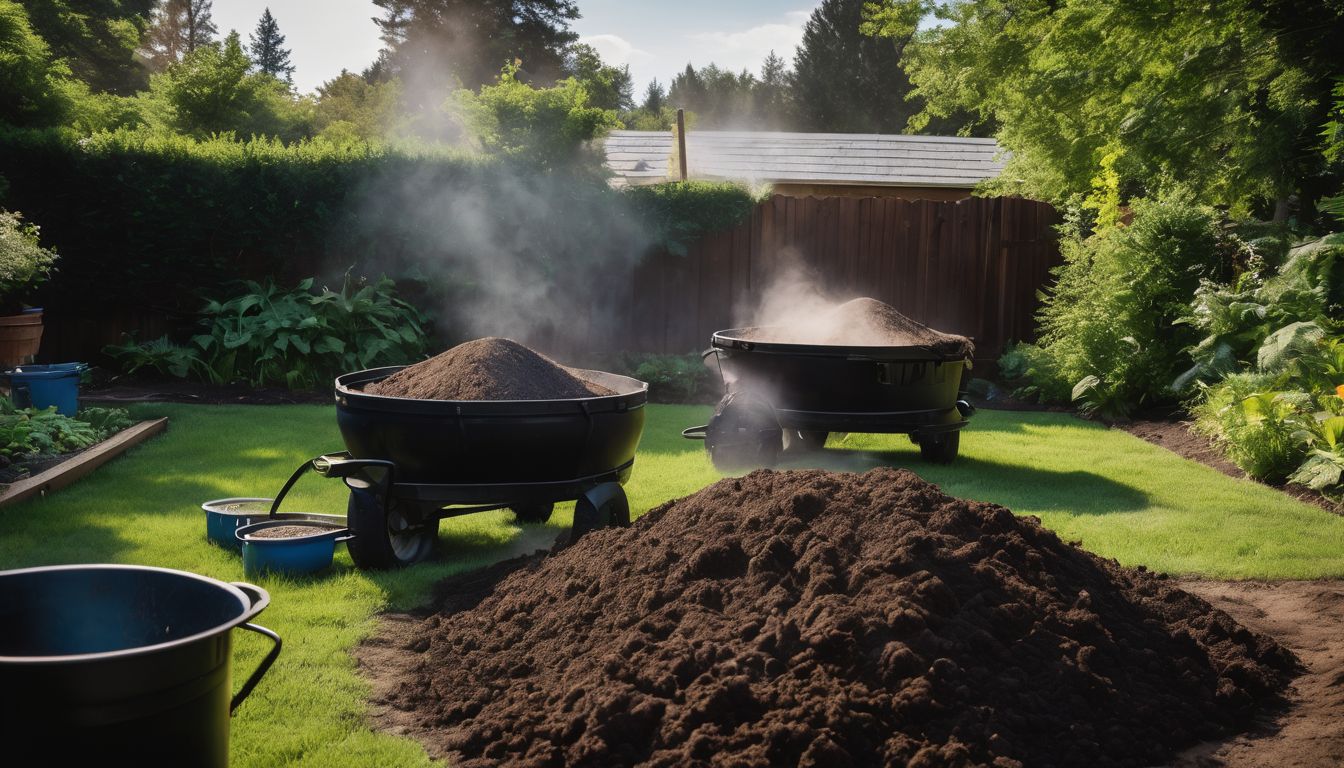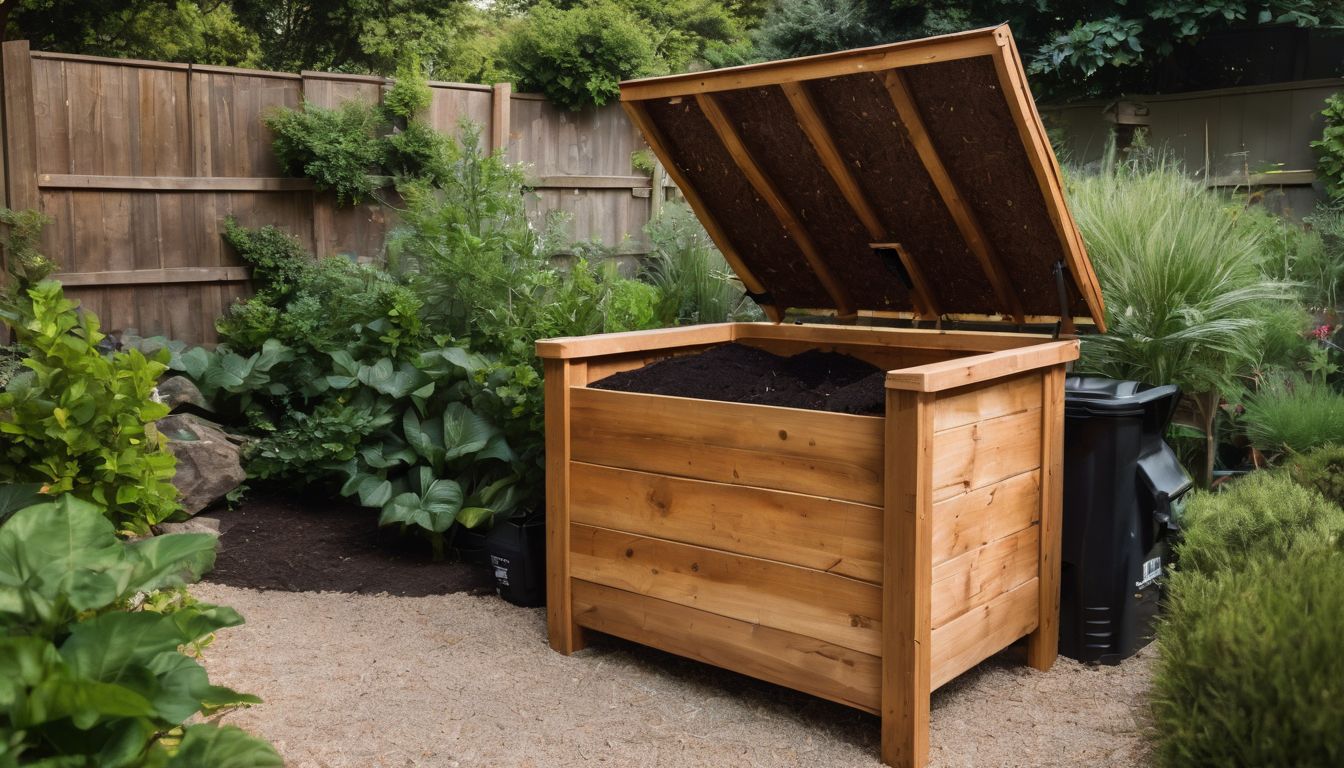Are you looking for a clever way to turn your kitchen scraps into garden gold? Vermicomposting harnesses the humble worm to revolutionise recycling organic waste. This article guides you through creating and maintaining your own worm composting system, ensuring successful soil enrichment and waste reduction.
Let’s dig in!
Key Takeaways
- Vermicomposting uses specific worms like Eisenia fetida, commonly known as red wigglers, to break down organic waste into nutrient-rich compost.
- This type of composting is beneficial because it enriches the soil with essential nutrients, reduces landfill waste, and lessens the need for chemical fertilisers.
- A successful vermicomposting system requires a suitable bin and bedding, appropriate feeding of the worms with organic kitchen scraps while avoiding meats and dairy, and maintaining an ideal environment that’s damp, dark, well-aerated but not too hot or cold.
- Regular maintenance such as harvesting vermicompost when ready and managing any potential issues helps keep the vermicomposting system productive.
- By engaging in vermicomposting at home or within community gardens can significantly impact environmental conservation efforts.
What is Vermicomposting?
Vermicomposting is the process of using worms to break down organic waste, such as kitchen scraps and garden debris, into nutrient-rich compost. It is a sustainable and natural way to recycle organic material and improve soil health.
The use of worms sets it apart from traditional composting methods.
Definition
Vermicomposting is a process that harnesses the natural digestion powers of earthworms to convert organic material into a rich soil amendment. In this eco-friendly approach, worms eat through biodegradable waste such as kitchen scraps and garden clippings.
As they move through the material, their digestive systems transform it into high-quality compost or ‘vermicast’. This vermicast, packed with nutrients essential for plant growth, serves as a potent natural fertiliser that supports sustainable gardening.
Engaging in vermicomposting not only recycles organic matter but also significantly reduces contributions to landfills. It’s an efficient form of recycling that encourages nutrient cycling and leads to the production of odour-free compost highly beneficial for any garden.
Now let’s explore why worm castings are so invaluable in creating lush gardens and how they differ from traditional composting methods.
Benefits of Vermicomposting
Vermicomposting enhances soil health
- Nutrient – rich vermicompost provides essential minerals for plant growth
- Reduces the need for chemical fertilisers, promoting organic and sustainable gardening practices
- Reduces the amount of organic waste sent to landfills, contributing to a cleaner environment
- Produces odor – free compost that is beneficial for indoor and outdoor use
Difference between Vermicomposting and traditional composting
Understanding the advantages of vermicomposting naturally leads to curiosity about how it compares with traditional composting methods. The table below highlights the key differences between these two approaches to organic waste conversion.
| Vermicomposting | Traditional Composting |
|---|---|
| Employs specific worms to break down organic matter | Relies on microorganisms for decomposition |
| Operates well in small, indoor spaces | Typically requires an outdoor setting |
| Produces compost faster than traditional methods | Decomposition can take several months to complete |
| Minimal odor if managed correctly | Could emit a strong smell if not aerated properly |
| Requires balanced feeding and avoidance of certain materials | Can handle a wider variety of organic waste |
| Generates worm castings, a highly nutritious compost | Creates humus, which enriches soil structure |
| Less labor-intensive once established | May need regular turning and monitoring |
| Controls pests through worm activity | Pests can be a problem if compost is not managed well |
With these differences in mind, vermicomposting presents itself as a valuable alternative to traditional composting, especially for those looking to reduce waste and create a sustainable nutrient source for plants.
Types of Worms Used for Vermicomposting
The most commonly used worm for vermicomposting is the Eisenia fetida, also known as red wigglers. Other species that can be used include Lumbricus rubellus and Perionyx excavatus.
These worms are highly efficient at breaking down organic materials and producing nutrient-rich vermicompost.
https://www.youtube.com/watch?v=xDhl-Ol8deU
Eisenia fetida
Eisenia fetida, also known as red wigglers or compost worms, are the most commonly used species for vermicomposting. These worms have a voracious appetite and can consume half their body weight in organic waste each day.
They thrive in moist, aerated environments and are well-suited for processing kitchen scraps and other biodegradable materials. Eisenia fetida is prized for its ability to rapidly break down organic matter into nutrient-rich castings, making it an excellent choice for home composting systems.
Their efficiency in converting waste into high-quality fertiliser makes them essential contributors to sustainable waste management practices.
In addition to being efficient decomposers, Eisenia fetida helps maintain a healthy microbial balance within the composting system. Their burrowing activity enhances soil aeration and drainage while creating channels that facilitate the breakdown of organic materials through aerobic decomposition.
Other species that can be used
Vermicomposting can involve other species of worms in addition to Eisenia fetida. These worms are also effective in breaking down organic material and producing nutrient-rich vermicompost. Each of these species has unique characteristics that make them suitable for vermicomposting:
- Perionyx excavatus
- Lumbricus rubellus
- Eudrilus eugeniae
- Dendrobaena veneta
Setting Up Your Vermicomposting System
Setting up your vermicomposting system involves providing the right environment for the worms, including a suitable bin and bedding, as well as choosing an ideal location for the bin.
You’ll also need to make sure you’re feeding the worms appropriately to ensure successful composting.
What worms need
When setting up a vermicomposting system, it’s important to provide the worms with the following:
- Moisture: Worms need a damp environment to thrive, so ensure that the bedding remains moist but not waterlogged.
- Oxygen: Adequate aeration is crucial for the worms, so regularly turn and fluff the bedding to prevent compacting.
- Darkness: Worms are sensitive to light, so keep the bin covered or in a dark place.
- Appropriate temperature: Maintain temperatures between 15-25°C (59-77°F) for optimal worm activity.
- Suitable bedding material: Use materials like shredded newspaper, cardboard, or coconut coir as bedding for the worms to live and reproduce in.
What worms eat
Worms eat a variety of organic materials, including:
- Fruit and vegetable scraps
- Coffee grounds and filters
- Tea bags (remove staples)
- Eggshells (crushed)
- Shredded newspaper and cardboard
- Small amounts of yard waste like grass clippings and leaves
Appropriate bin and bedding
To set up an efficient vermicomposting system, select a well-ventilated container such as a plastic or wooden bin. Bedding materials such as shredded newspaper, cardboard, or coconut coir provide a comfortable environment for the worms. Avoid using glossy paper or printed materials as bedding to prevent harmful chemicals from leaching into the compost. The bin should have drainage holes to prevent moisture build-up and ensure good air circulation. Place the bin in a shaded area to protect the worms from extreme temperatures while allowing them access to fresh air.
Ideal location for the bin
Finding the right location for your vermicomposting bin is crucial. Choose a spot that’s sheltered from direct sunlight and extreme temperatures, such as a shaded area in the garden or a cool corner of the garage.
Ensure it’s easily accessible so you can regularly tend to your composting worms and add food scraps. The ideal location will provide good ventilation, so consider placing the bin in a well-ventilated area to prevent any potential odor issues.
Now that you’ve chosen the perfect location for your vermicomposting bin, let’s delve into maintaining your system to ensure optimal results.
Maintaining Your Vermicomposting System
To maintain your vermicomposting system, ensure that the worms are fed regularly with appropriate food scraps and avoid overfeeding. Harvesting the vermicompost when it is ready and addressing any potential issues promptly will help to keep your system healthy and productive.
How to feed the worms
To feed the worms, consider the following:
- Provide a balanced diet of kitchen scraps, fruit and vegetable peels, coffee grounds, and eggshells.
- Cut or blend the food into smaller pieces to make it easier for the worms to consume.
- Avoid feeding them meat, dairy products, oily foods, and citrus fruits as these can attract pests or produce odors.
- Add food gradually and bury it under the bedding to prevent pests and odors.
- Moisture is crucial; maintain a damp environment by misting the bedding if it starts to dry out.
- Monitor the food consumption and adjust accordingly to prevent overfeeding or underfeeding.
Harvesting vermicompost
Harvesting vermicompost is a simple process that involves separating the worms from the finished compost. Here’s how to do it:
- Move the contents of the bin to one side, and add fresh bedding material to the other side.
- Place food scraps only on the new bedding side for a few weeks.
- The worms will migrate to the new bedding area to feed, leaving behind rich vermicompost in the old section.
- Once most of the worms have moved, carefully remove the vermicompost and set it aside.
- Screen out any remaining worms or cocoons from the harvested compost before using it in your garden.
Dealing with potential issues
- Dealing with potential issues
- Managing fruit flies and other pests
- Controlling odors
- Balancing moisture levels
- Preventing overheating
- Addressing slow decomposition
- Managing acidity levels
- Avoiding overfeeding
- Preventing escapees
Benefits of Vermicomposting
Vermicomposting produces nutrient-rich vermicompost, reduces waste, and has a reduced environmental impact. It also provides free fertiliser for gardens and plants.
Producing nutrient-rich vermicompost
Vermicomposting produces nutrient-rich vermicompost, a dark and crumbly soil amendment that is full of beneficial microorganisms. This rich fertiliser enhances soil structure, aids water retention, and boosts plant growth.
Using worms to break down organic waste creates a potent compost teeming with essential nutrients like nitrogen, phosphorus, potassium, and micronutrients necessary for healthy plant development.
The resulting vermicompost is an eco-friendly alternative to chemical fertilisers that helps reduce reliance on synthetic products while promoting sustainable gardening practices. By enriching the soil naturally, vermiculture offers a cost-effective solution for producing high-quality organic fertilisers without harmful environmental impacts.
Reducing waste
By vermicomposting, organic waste can be significantly reduced and repurposed into nutrient-rich fertiliser for gardens and plants. This process diverting biodegradable waste from landfills helps alleviate the environmental burden of excess landfill waste.
Through vermiculture, a considerable amount of kitchen scraps, yard trimmings, and other organic materials can be upcycled into valuable compost. The resulting reduction in waste not only benefits individual households but also contributes to the overall sustainability and preservation of the environment.
Vermicomposting economises on precious resources by transforming biodegradable waste materials that would otherwise take up space in landfills into a beneficial product for soil health and plant growth.
Reduced environmental impact
Vermicomposting reduces environmental impact by diverting organic waste from landfills, where it would emit harmful greenhouse gases. Instead, this waste becomes valuable nutrient-rich vermicompost that enriches the soil and helps plants grow.
By using worms to break down biodegradable materials, vermiculture minimises the need for chemical fertilisers, reducing pollution in waterways and preserving natural habitats.
Moreover, vermicomposting contributes to a sustainable cycle by creating a closed-loop system at home or in community gardens. This process decreases reliance on external inputs and promotes self-sufficiency in nutrient management for gardens and plants.
Free fertiliser for gardens and plants
Vermicomposting produces nutrient-rich vermicompost, a free fertiliser for gardens and plants. This organic fertiliser is rich in essential nutrients that enhance soil quality and promote healthy plant growth.
When applied to gardens and potted plants, the vermicompost helps improve soil structure, retain moisture, and promote robust root development.
The use of vermicompost also reduces the need for chemical-based fertilisers, contributing to sustainable gardening practices. By choosing vermicompost as a natural fertiliser option, environmentally conscious individuals support eco-friendly waste management while promoting healthier and more vibrant gardens and plants.
Conclusion
In conclusion, vermicomposting offers an eco-friendly solution to managing biodegradable waste. Using worms to enhance composting can significantly reduce environmental impact and produce nutrient-rich fertiliser for gardens.
By understanding the benefits and setting up a suitable system, individuals can contribute to sustainable waste management practices while also enriching their gardens with organic nutrients.
Maintaining a vermicomposting system does require effort but the rewards of creating odor-free compost and reducing overall waste make it a worthwhile endeavour for environmentally conscious individuals.
FAQs
1. What is vermicomposting?
Vermicomposting uses specific earthworm species to break down biodegradable waste and enhance home composting techniques.
2. How does worm farming benefit my garden’s soil?
Through worm farming, worms convert organic waste into nutrient-rich composted soil, acting as an effective natural fertiliser for your plants.
3. Can vermicomposting reduce bad smells from compost heaps?
Yes, a properly maintained vermicompost system can create odour-free compost by managing the decomposition process more efficiently than traditional methods.
4. Are there common mistakes to avoid in vermicomposting?
Absolutely! It’s important not to overfeed or neglect the moisture levels in your bin as these are typical composting mistakes that can harm the health of your worms and quality of your compost.





